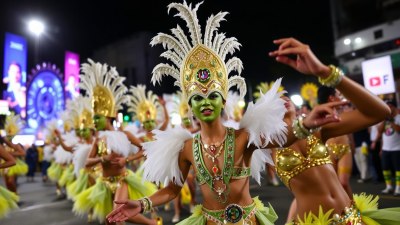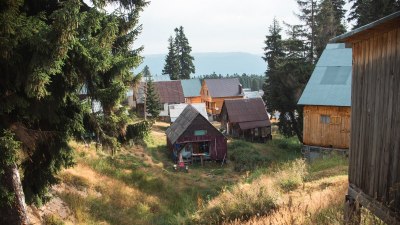Rio de Janeiro's Samba Schools: Dancing the Night Away at Carnival
Explore the vibrant samba schools of Rio de Janeiro and their role in the dazzling Carnival celebrations.

Image created with Flux Schnell
The world-renowned Carnival in Rio de Janeiro is a spectacular celebration that showcases the rich culture and traditions of Brazil, with samba music and dance at its heart. Every year, thousands of visitors flock to the streets to witness the infectious rhythm and vibrant costumes that define this iconic festival. Central to this event are the samba schools of Rio de Janeiro, each playing a vital role in the Carnival festivities.
Samba schools, known as 'escolas de samba,' are community-based organizations that focus on the performance of samba music and dance. Each school is a reflection of its neighborhood and represents a unique blend of culture, history, and social commentary. The schools prepare throughout the year for the Carnival, dedicating countless hours to choreographing dances, designing costumes, and crafting elaborate floats that will be showcased during the parade.
The Importance of Samba Schools
Samba schools are more than just performance groups; they serve as a social and cultural hub for their communities. They provide a sense of identity and unite people from all walks of life, transcending social and economic barriers. Through their vibrant rehearsals and community events, samba schools foster a spirit of togetherness and pride, creating a sense of belonging that is particularly palpable during Carnival.
Each year, the samba schools compete in a grand parade held at the Sambadrome, a venue specially designed for this event. The parade is the culmination of months of hard work and dedication. Schools are judged based on various criteria, including the quality of their samba rhythm, choreography, costumes, and overall presentation. This friendly competition fuels the excitement and creativity that permeates the Carnival atmosphere.
A Brief History of Samba Schools
The roots of samba schools can be traced back to the early 20th century when samba music began to gain popularity in Rio de Janeiro. The first samba schools were established in the 1920s as informal groups of musicians and dancers who came together to celebrate and perform samba music. Over time, these gatherings evolved into organized groups that formalized their structure and purpose.
By the 1930s, samba schools started to gain recognition and began participating in competitions. The famous Carnival parade, as we know it today, started to take shape during this time. The influence of the samba schools continued to grow throughout the decades, becoming synonymous with Rio de Janeiro's Carnival and Brazilian culture as a whole.
Rehearsals and Preparation
The preparations for Carnival begin long before the event itself. Samba schools organize weekly rehearsals that are open to the community, allowing anyone interested to join in the dance and music. These rehearsals serve not only to refine choreography but also to foster camaraderie among members. It's a time for individuals to come together, share their passion for samba, and strengthen their link to the school.
The process of designing costumes and floats is another crucial aspect of each school's preparation. Each year, the samba schools select a theme that often reflects social issues, historical events, or cultural anecdotes. This theme guides the creation of costumes, floats, and the parade narrative. Costume designers work tirelessly to produce eye-catching outfits that showcase the creativity and artistry of the samba school, often featuring dazzling sequins, feathers, and bright colors.
The Parade: A Night to Remember
The highlight of the Carnival is undoubtedly the parade at the Sambadrome. Watching the parade is an exhilarating experience for both participants and spectators. On the night of the parade, the atmosphere is electric, filled with excitement and anticipation. The samba schools march into the Sambadrome, each one showcasing their theme through dynamic performances filled with intricate choreography and pulsating rhythms.
The sound of drums fills the air while samba dancers grace the stage with their energy and charm. The floats, adorned with breathtaking designs, weave through the Sambadrome, telling stories and captivating audiences. Each performance is a spectacle that celebrates the creativity, talent, and spirit of the samba school.
Notable Samba Schools in Rio de Janeiro
Several samba schools have gained fame and recognition over the years, each with its own unique flair and legacy. Beija-Flor de Nilópolis is one of the most successful schools in Carnival history, known for its elaborate floats and innovative performances. São Clemente, renowned for its social commentary, captivates audiences with thought-provoking themes.
Portela is another historic samba school, celebrated for its deep cultural roots and unique blend of tradition and modernity. Mangueira, with its vibrant colors and community spirit, is often regarded as the heart and soul of samba in Rio. These schools, along with many others, contribute to the entire Carnival experience, making it a celebration of joy, unity, and culture.
The Influence of Samba Beyond Rio
While Rio de Janeiro is often considered the epicenter of samba, the influence of samba schools reaches far beyond the city. Samba has spread across Brazil and internationally, inspiring countless artists and dancers around the world. This cultural phenomenon has led to the development of various regional styles and forms of samba, each with its own unique flavor.
In recent years, international events celebrating samba have emerged, showcasing the dance and music to diverse audiences. Samba workshops and dance classes have become popular around the globe, allowing enthusiasts to learn and appreciate the beauty of this vibrant art form.
The Role of Samba Schools in Social Issues
Samba schools often use their platform to address significant social issues. Many schools highlight themes related to inequality, racism, and environmental concerns in their performances. By doing so, they raise awareness and provoke thought among audiences, making Carnival not only a celebration of joy but also a chance for reflection and change.
The storytelling aspect of samba is powerful, with schools using their floats and dancers to narrate important messages. This blend of entertainment and advocacy allows samba schools to make an impact beyond the stage, leading to meaningful discussions within communities and beyond.
Experiencing Carnival
For those looking to experience the Carnival celebrations in Rio de Janeiro, attending the samba parade is a must. Tickets to the Sambadrome can be purchased in advance, and options range from grandstand seats to VIP boxes. Additionally, immersing oneself in the street parties held throughout the city allows for a more intimate encounter with local culture and tradition.
Participating in blocos, or street parties, is a fantastic way to enjoy the Carnival spirit. These free events feature samba music, dancing, and parades through the streets, showcasing the vibrant culture and energy of Rio. Engaging with locals and experiencing spontaneity during these events is an unforgettable aspect of the Carnival journey.
Rio de Janeiro's samba schools are at the heart of the Carnival experience, serving as a testament to the rich cultural heritage of Brazil. Through their performances, they bring the community together, celebrate creativity, and address social issues, all while providing joy and entertainment. The preparation, dedication, and passion that each school pours into its Carnival presentation are a reflection of their love for samba and their desire to share it with the world. As the beats of samba continue to echo through the streets of Rio, the legacy of these samba schools will undoubtedly endure, paving the way for future generations to revel in the beauty and excitement of this extraordinary celebration.











